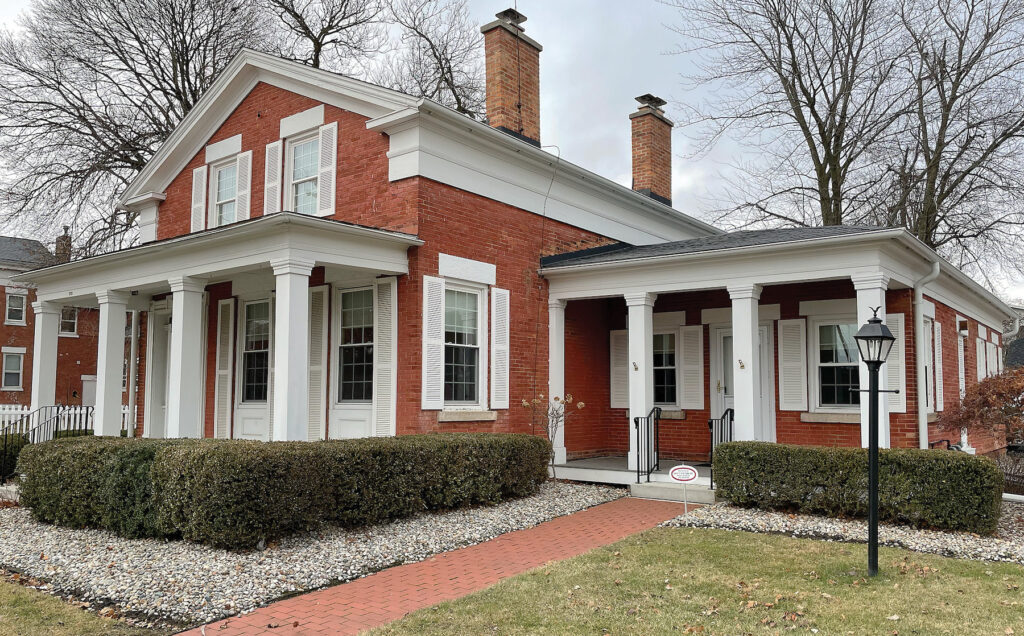
ADRIAN — The historic Governor Charles M. Croswell house at 228 N. Broad St. will open to the public for guided tours on selected Fridays in 2024, according to Nancy Kujda, Regent of the Lucy Wolcott Barnum Chapter of the National Society of the Daughters of the American Revolution. Adrian’s DAR has scheduled the tours to coincide with selected First Fridays in Adrian.
The chapter plans to have members available at the house on the evenings of Friday, June 7, and Friday, Aug. 2, with hopes to possibly expand the number of dates in 2025.
Small groups can also arrange visits by appointment.
The DAR’s decision to offer these tours reflects Kujda’s desire to focus the chapter’s energies on community outreach, historic preservation, and recruitment.
“These tours will provide history buffs with a rare opportunity to view his well-preserved Greek-Revival style home, which has been little changed since the 1840s, and to learn about the DAR and the remarkable life of Governor Charles Croswell,” Kujda said.
Among the few updates to the house since it was built in the early 1840s are its charming 1920s kitchen and its 1949 auditorium added to the back of the structure to accommodate the DAR chapter’s meetings.
The DAR has owned and maintained the building since 1927. Prior to that, the house remained in the possession of Croswell’s extended family until his second wife, Elizabeth Musgrave Croswell Merrill, donated it to the DAR as a memorial to her husband. Its first owner was the builder Daniel Hicks, who was Croswell’s uncle and guardian following the death of his mother and sister from yellow fever in 1832 and his father’s accidental drowning in the Hudson River just a few months later — when Charles was just seven years old.
Croswell and Hicks arrived in Adrian in 1837 from Newburgh, New York, to help satisfy the intense demand here for housing. During the previous seven years, Lenawee County’s population had ballooned ten-fold from 1,491 in 1830 to 14,878.
At age 16, Croswell (1825–1886) became his uncle’s carpenter assistant, and together they built their own home as well as many of the region’s oldest structures. Tragically, within a decade, Hicks died of cholera, which he contracted while serving in the Mexican-American War. Croswell then purchased the home from his uncle’s widow.
In 1846, Croswell decided to study law, which had also fascinated several of his father’s relatives in Connecticut and New York. Among them was the anti-racist Harry Croswell (1778-1858), who had waged an infamous court battle with President Thomas Jefferson that tested the limits of press freedom. Later, Harry became an Episcopalian minister and passionately supported the strict separation of church and state.
In 1854, Croswell became a founding member and Secretary of the newly formed Republican Party before establishing a law partnership in Adrian with Thomas Cooley; Cooley would later become the Chief Justice of the Michigan Supreme Court. Croswell was then elected Mayor of Adrian before serving as a Michigan State Senator from 1863 to 1868 and then as a State Representative and Speaker of the House from 1873 to 1874. He was twice elected governor of Michigan in 1876 and 1878, during which time he oversaw the completion of the Capitol building in Lansing. His notable political positions include his opposition to the death penalty, his actions to ratify the 13th Amendment to abolish slavery, and his outspoken praise for Abraham Lincoln’s Emancipation Proclamation.
The Croswell House is notable for the ways its design reflects the governor’s personality. Croswell’s biography described his public speaking style as “terse, clear, and strong, without excess of ornament.” The same can be said about his taste in architecture and furniture. Especially notable are his home’s elegant, boxy exterior that displays the Greek Revival’s most characteristic features: its low-pitched roof in imitation of a Greek temple, its unadorned, broad frieze board under the roof line, and its symmetrical placement of windows and doors. A similar, sober aesthetic is visible in the home’s interior, where the fireplace, windows and doors retain their original trim that is ornamented with unfluted pilasters and bold pyramidal bosses. Moreover, the auditorium showcases Croswell’s finely proportioned law library bookcase, which Croswell built for himself in the Renaissance style. Its arched windows are composed of simple square and circular shapes decorated with narrow drip moldings.
According to DAR’s website, the National Society was founded in 1890 as a non-profit, non-political volunteer service organization dedicated to historic preservation, education, and patriotism.
There are more than 3,000 local DAR chapters across the globe with membership open to women eighteen years or older who can prove lineal, bloodline descent from anyone who aided in achieving American independence.
Adrian’s local DAR chapter was organized in 1909 and named for the great-grandmother of founding Regent Louise Barnum Robbin, whose father and brother served as soldiers in the Revolutionary War. Members of the local DAR assist with genealogical research and solicit grants to maintain and improve their building and grounds. The Governor Charles M. Croswell House was designated a Michigan State Historic Site in 1958 and added to the National Register of Historic Places in 1972.
To contact the Lucy Wolcott Barnum Chapter of the National Society of the Daughters of the American Revolution, visit their website at www.lucywolcottbarnumnsdar.com.
Peter Barr, Ph.D., is the author of adrianarchitecture.org.

